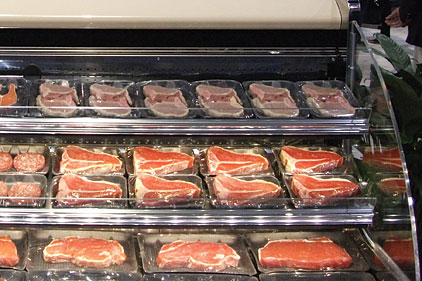For example, there are:
• Different energy equations for different types of open display cases.
• Test standards and energy factors from the Air-Conditioning, Heating, and Refrigeration Institute (AHRI) for walk-ins.
• Pending new Energy Star levels for ice machines.
• Changes in Consortium for Energy Efficiency tiers for reach-in units with doors.
“Today’s voluntary guidelines become tomorrow’s state and federal policies. It’s critical to keep abreast of the pending changes to energy regulations to ensure both compliance with new legislation and participation in energy-saving incentives,” said Jim Mozer, vice president and general manager of refrigeration marketing and integrated products at Emerson Climate Technologies.
That’s why Emerson recently issued a white paper called Status of Energy Regulations for Commercial Refrigeration Equipment.
“This white paper is part of our commitment at Emerson Climate Technologies to make sure that OEMs, contractors, and retailers have the most current information they need to assist in compliance with the latest industry-changing regulations,” Mozer said.
The white paper was authored by Brian Buynacek, senior consultant with Emerson’s Design Service Network.
HIGHLIGHTS
Among the key highlights:• “Energy regulations are generally introduced as voluntary guidelines, which later become established law. In 2001, the Environmental Protection Agency’s (EPA) Energy Star program enacted voluntary energy-consumption guidelines for commercial refrigerators and freezers. The California Energy Commission (CEC) subsequently used those guidelines as the basis for a state law mandating new standards, while outlawing the sale of nonconforming products. Federal minimum energy levels are now set at those original levels and even higher Energy Star levels have been established.
• “In 2005, the Air-Conditioning and Refrigeration Institute (ARI) took a proactive step toward the industry’s involvement in energy-consumption standards, recommending standards to Congress that were equal to the most stringent in California. The Energy Policy Act of 2005, which included ARI recommendations, became national law and went into effect in 2010.
• “More regulation is on the horizon. Additional standards for ice machines are expected in 2011, and the Department of Energy (DOE) made a ruling on display cases that will become effective in 2012.”
• “OEMs can comply with existing and pending energy-use regulations by selecting the most efficient component products. For example, the compressor can be responsible for up to 60 percent of a system’s total energy use. Evaporator- and condenser-fan motors are the second largest energy-consuming components.”
• “Scroll compressors and electronic-commutated motors are the most efficient compressor and motor options. Additional technologies, including system controllers, component diagnostics and monitoring software, can also help reduce overall product energy use.
• “One goal of the Energy Policy Act of 2005 was to establish one national energy-efficiency standard for most products. Different energy standards in various states had led to confusion among consumers and businesses. While it is possible for states to challenge the EPA in order to establish stricter energy guidelines, it is not expected that any stricter state standards will go into effect before 2015. Various local and regional utility rebates based on CEE criteria will gradually encourage the adoption of even more efficient refrigeration equipment.”
INCENTIVES AND SOLUTIONS
The white paper encourages contractors to search out financial incentives to offer to customers in order to install complying equipment. These can come from utilities as well as local, state, and federal sources.The paper also encourage attention to the Leadership in Energy and Environmental Design (LEED) Green Building Rating System, as, in fact, interest in that often comes from building owners. “Concern for the environment and sustainable development is growing, and LEED is a way that businesses can prove they are good corporate citizens. LEED promotes a whole building approach to sustainability through the principles of green building and integrated building design. There is a conscious effort to systematically integrate the design of building systems, such as HVAC, refrigeration, lighting, water management, and other mechanical systems with the building design itself, so as to achieve higher levels of performance,” the white paper said.
Toward the end of the paper, Emerson noted that it was a manufacturer that offered energy efficient solutions in such areas as refrigeration compressors, condensing units, thermal expansion valves, overall retail solutions, and end-user monitor systems.
EDITOR’S NOTE: The entire white paper can be downloaded at no charge by going to www.emersonclimate.com/energysolutions.
Publication date:07/18/2011



Report Abusive Comment